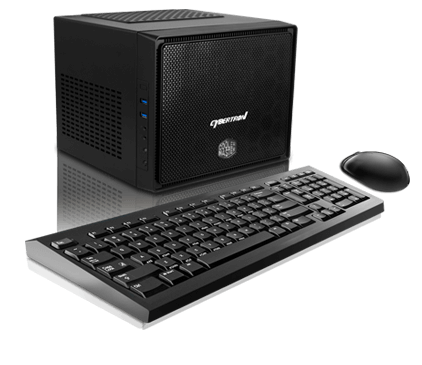CybertronPC Offers New System Based Around AMD R9 Nano
CybertronPC announced the availability of a brand-new customizable PC sporting the new AMD Radeon R9 Nano (our review here). Unlike other companies simply adding the compact and powerful graphics card as a selectable option in its existing configurations, CybertronPC went so far as to create a whole new system designed specifically around the new Nano, the CybertronPC Nanotron.
The CybertronPC Nanotron is the company's first small-form factor desktop gaming PC and is advertised as a 4K and VR gaming system. Under the hood of the rebranded Coolermaster Elite 110 case is an EVGA Z170 Stinger mini-ITX motherboard with the new Intel Core i7 6700K quad core processor inside. A liquid cooling solution keeps temps of the unlocked chip low. Baseline models of the Nanotron include 16 GB of DDR4-2133 memory, a 500 GB SSD and a 2 TB 7200 RPM hard drive, but these options can be upgraded. A 450 W 80 PLUS Gold certified modular PSU powers the rig.
The AMD Radeon R9 Nano is the Fiji-based, HBM memory-loaded little brother of the R9 Fury (but don't call it Fury), and in our review, we concluded that the graphics card really is in a "class of its own," offering more graphics horsepower with less power consumption and noise than the next closest product in the "mini graphics card" space. Although our tests at FHD resolutions showed the 4096 shaders and 4096 MB of memory throttling, if 4K gaming is the goal, CybertronPC picked an excellent graphics card to get you there. Fiji loves 4K.
Although some may wonder why a system built around the awesome power of an AMD graphics card doesn't offer flagship AMD chipsets, the reasoning is fairly simple: AMD board partners just aren't in the business of making mini-ITX motherboards. There are a few, but these offerings usually support the company's APU (FM2+) lineup, and it simply cannot match the performance of the latest Skylake processors from Intel.
Another perplexing design choice was the case. The rebranded Coolermaster Elite 110 case CybertronPC uses for the Nanotron can fit much larger graphics cards than the 6-inch R9 Nano. The R9 Nano may be in "a class of its own," but only because it packs the power of larger graphics cards into a smaller form factor. With a case that accommodates larger graphics cards, it feels like that saved space is wasted. We could even understand using that particular case if CybertronPC were offering different (and larger) graphics configuration options for the Nanotron, but the company is hitching its small-form factor flagship wagon solely to the Radeon R9 Nano horse.
However, the CybertronPC Nanotron looks on paper like an excellent 4K gaming system. Extra space for more air flow and less power consumption and noise is never a bad thing for gamers, and the performance of the R9 Nano may be enough to justify the $2,499.99 starting price for enthusiasts looking for the best frame rates at 4K resolutions in a mini-ITX form factor.
Follow Derek Forrest @TheDerekForrest. Follow us @tomshardware, on Facebook and on Google+.
Get Tom's Hardware's best news and in-depth reviews, straight to your inbox.
Derek Forrest was a contributing freelance writer for Tom's Hardware. He covered hardware news and reviews, focusing on gaming desktops and laptops.
-
HideOut Looks like an excelent 4K gaming system? THG's on reviews of the R9 family say otherwise. Not enough gpu power and 4gig of HBM isnt really enough. But hey. Nice advertisement. Next year's updated graphics will be where the real 4K comes in from both manufacturers. 8+gig of HBM and a bit of an update on the gpu side (perhaps a huge update with the new finfet manufacturing) will be the real 4K deal.Reply -
tom10167 I was excited until I saw the case. The way to highlight the Nano is to put it in the smallest case that can possibly fit it. A 6700k is perplexing to nobody but using an over the shelf case is a major disappointment.Reply -
alidan ReplyLooks like an excelent 4K gaming system? THG's on reviews of the R9 family say otherwise. Not enough gpu power and 4gig of HBM isnt really enough. But hey. Nice advertisement. Next year's updated graphics will be where the real 4K comes in from both manufacturers. 8+gig of HBM and a bit of an update on the gpu side (perhaps a huge update with the new finfet manufacturing) will be the real 4K deal.
nothing really handles 4k well yet, there is no single gpu solution without turning graphics settings down, but if benchmarks are right, across the board amd offerings are better 4k than nvidia at this point, and unless something changes, dx12 is dominated by amd. it will be interesting to see if a new architecture from nvidia that handles dx12 well also hands dx11 as good as it has been. -
ozicom They also did not mention that you have to connect 4K monitor through Displayport only. Because AMD did not put HDMI 2.0 support to it's cards yet and you can get 4K 60Hz only by using DP port. HDMI organization announced HDMI 2.0 specs but AMD don't care. Because only rich people who can pay 1000+USD deserve 4K display output.Reply -
Duncan3601 If the case can support a radiator for water cooling, and longer graphics cards, then the Fury X just makes more sense...... The Nano is a cool and interesting product, but it's still not very practical for anything other than the absolutely smallest system possible, and for the power-efficiency.Reply
